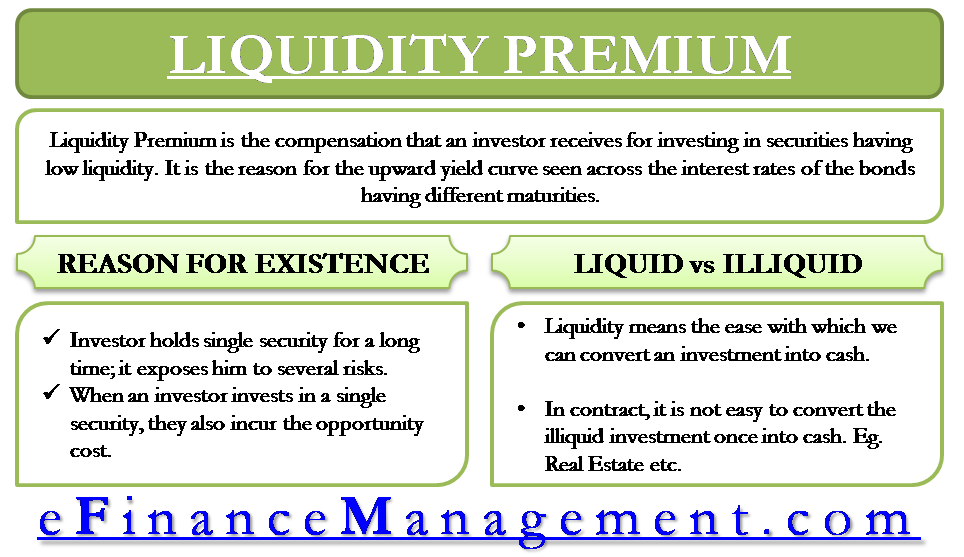The liquidity premium is the compensation that an investor receives for investing in securities having low liquidity. Liquidity refers to the ease with which we can convert an investment into cash. The liquidity premium is the reason for the upward yield curve seen across the interest rates of the bonds having different maturities. The bonds having long maturity terms carry higher risks, and investor demands the liquidity premium.
Why Does Liquidity Premium Exist?
Investments with low liquidity carry more risk than those with high liquidity. The reason is that when the investor holds single security for a long time, it exposes him to several risks. Such as market volatility, economic changes, and fluctuation in interest rates. Also, when an investor invests in a single security, they also incur the opportunity cost. They could have invested in some other security that would have been better than the low liquidity investment. Because of this additional risk, the investors demand a higher return; we call this a liquidity premium.

Liquid and Illiquid Investment
Liquidity means the ease with which we can convert an investment into cash without sacrificing the fair market value. Treasury bills and stocks are examples of liquid investments. Stocks operate on an auction system. The difference between the price the buyer will pay and what the seller is ready to accept is very less. If someone wants to sell a share, he can enter a bid price (the highest price offered), and they will complete the trade in a matter of seconds.
On the other hand, investment in real estate is an example of illiquid investment. Selling a house at a fair market price will take time. Sure, we can sell the house quickly if we are willing to sell the house at a price that is lower than the market price. But this is opposite to the concept of liquidity.
There is a wide range of degrees of liquidity within the asset of the same class. Bonds are good examples. The short-term Treasury bills are liquid, whereas the long-term bonds, a small or unknown company issue, are very difficult to sell in the open market as they will face the difficulty in finding a buyer.
Investment Commitment
The illiquid investments require an investor to hold an investment for the entire investment period. An investor investing in these investments expects a premium (liquidity premium) for taking the risk by locking their funds in a particular investment for a longer time. The terms liquidity premium and illiquidity premium are interchangeable. Both terms refer to the same idea that the investor should receive the premium for investing in long-term investments.
The shape of the yield curve can further help to explain the liquidity premium that the investor demands for long-term investments. In a balanced economy, long-term investments receive a higher rate of return as compared to short-term investments. Thus the shape of the yield curve is upward sloping.
For another example, let us assume there is an investor who wants to purchase one of two bonds that have the same coupon payments and the same time of maturity. One of these bonds is traded in the public exchange while the other is not. The investor is not willing to pay more for the non-public bond. Thus, he will receive a premium at maturity. This difference between the prices and the yields is the liquidity premium.

